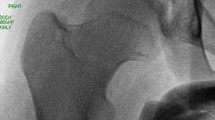Abstract
Introduction
Tears of the abductor mechanism of the hip are well recognized, but poorly understood. Little is known of the effect of demographics and pathology on prevalence of abductor mechanism tears or the impact on clinical outcome.
Methods
This prospective study analysed the effect of age, gender, medical co-morbidity and social deprivation on prevalence of abductor mechanism tears of the hip in 835 consecutive patients undergoing total hip arthroplasty (THA) between 2003 and 2011. Effect on clinical outcome relating to presence of abductor mechanism tear was analysed in a subset at pre-op and at 1 year post-operation using the Oxford hip score (OHS).
Results
The prevalence of abductor mechanism tears was 25.4 % (n = 212). Female patients (p < 0.001), older patients (p = 0.001) and those of lower socioeconomic status (p < 0.001) were significantly more likely to have a pre-operative abductor mechanism tear. In older socially deprived females the predicted rate of tear is 70.9 %. The aetiology of the hip disease (p = 0.593) or presence of any specific co-morbidity (p = 0.085–0.929) had no significant effect on the prevalence of abductor mechanism tears. In patients with protrusion or dysplasia there was an increased prevalence of tears (p = 0.002). There was no significant difference in pre-operative (p = 0.775) or post-operative (p = 0.604) OHSs regardless of the tears when the tears were recognized and treated at the time of THA.
Conclusions
Tears are increasingly prevalent in women of advancing years and lower socioeconomic status which should be considered when planning operative approach in this demographic. When recognised and repaired there is no difference in the clinical outcome for those with abductor mechanism tears of the hip.

Similar content being viewed by others
References
Bunker TD, Esler CNA, Leach WJ (1997) Rotator cuff tear of the hip. J Bone Joint Surg Br 79:618–620
Samilson RL, Binder WF (1975) Symptomatic full thickness tears of the rotator cuff. An analysis of 292 shoulders in 276 patients. Orthop Clin North Am 6(2):449–466
Howell GED, Biggs RE, Bourne RB (2001) Prevalence of abductor mechanism tears of the hips in patients with osteoarthritis. J Arthroplasty 16:120–124
Cates HE, Schmidt MA, Person R (2010) Incidental “rotator cuff tear of the hip” at primary total hip arthroplasty. Am J Orthop 39(3):131–133
Kagan A II (1999) Rotator cuff tears of the hip. Clin Orthop Relat Res 368:135–140
Davies H, Zhaeentan S, Tavakkolizadeh A, Janes G (2009) Surgical repair of chronic tears of the hip abductor mechanism. Hip Int 19(4):372–376
Carstairs V, Morris R (1991) Deprivation and health in Scotland. Aberdeen University Press, Aberdeen
Information Services Division Scotland (2010) Deprivation http://showcc.nhsscotland.com/isd//3211.html Accessed 12 Mar 2012
Hardinge K (1982) The direct lateral approach to the hip. J Bone Joint Surg Br 64:17–19
Schneider M, Kwahara I, Breusch SJ (2006) Modified Hardinge approach with limited incision. Der Orthopade 35:751–760
Dawson J, Fitzpatrick R, Carr A, Murray D (1996) Questionnaire on the perceptions of patients about total hip replacement. J Bone Joint Surg Br 78(2):185–190
Neer CS (1983) Impingement lesions. Clin Orthop 173:70–77
lohr JF, Uhthoff HK (1990) The microvascular pattern of the supraspinatus tendon. Clin Orthop Relat Res 254:35–38
Sher JS, Uribe JW, Posada A, Murphy BJ, Zlatkin MB (1995) Abnormal findings on magnetic resonance images of asymptomatic individuals. J Bone J Surg Am 77(1):10–15
Downing ND, Clark DI, Hutchinson JW, Colclough K, Howard PW (2001) Hip abductor strength following total hip arthroplasty: a prospective comparison of the posterior and lateral approach in 100 patients. Acta Orthop Scand 72(3):215–220
Jolles BM, Bogoch ER (2006) Posterior versus lateral surgical approach for total hip arthroplasty in adults with osteoarthritis. Cochrane Database Syst Rev 19(3):CD003828
Berry DJ, von Knoch M, Schleck CD, Harmsen WS (2005) Effect of femoral head diameter and operative approach on risk of dislocation after primary total hip arthroplasty. J Bone Joint Surg Am 87(11):2456–2463
Meek RM, Allan DB, McPhillips G, Kerr L, Howie CR (2006) Epidemiology of dislocation after total hip arthroplasty. Clin Orthop Relat Res 447:9–18
Kim YH, Choi Y, Kim JS (2009) Influence of patient-, design-, and surgery-related factors on rate of dislocation after primary cementless total hip arthroplasty. J Arthoplast 24(8):1258–1263
Conflict of interest
The authors’ declare that they have no conflict of interest.
Author information
Authors and Affiliations
Corresponding author
Rights and permissions
About this article
Cite this article
Hendry, J., Biant, L.C. & Breusch, S.J. Abductor mechanism tears in primary total hip arthroplasty. Arch Orthop Trauma Surg 132, 1619–1623 (2012). https://doi.org/10.1007/s00402-012-1573-9
Received:
Published:
Issue Date:
DOI: https://doi.org/10.1007/s00402-012-1573-9



